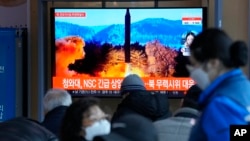North Korea indicated it had conducted a subsystems test for a planned reconnaissance satellite Sunday, raising concerns the state could be hinting at a more consequential long-range missile test.
North Korea’s Korean Central News Agency (KCNA) said Monday the "important test... confirmed the characteristics of the high-resolution camera system [to be loaded onto the satellite], data transmission system and attitude control devices and the correctness of their performance." The test was of "great significance," it said, overseen by the National Aerospace Development Administration and the Academy of Defense Sciences of North Korea.
Two images released with the statement showed a wide view of the Korean peninsula from orbital space, versus a zoomed in high-resolution capture by a satellite camera.
"The most important feature for a spy satellite is its camera," notes Park Won-gon, North Korean Studies professor at Ewha Womans University in Seoul. "The other is the launching mechanism."
South Korean and Japanese militaries had said Sunday morning's projectile launch, North Korea's eighth test this year and the first since the end of the Beijing Winter Olympics, was likely a ballistic missile. It logged a flight range of 300 kilometers and a maximum altitude of 620 kilometers, Seoul said, as it was fired from the Sunan Airport area to land in seas off the east coast of the Korean peninsula.
Technology behind a satellite delivery rocket and a long-range missile are very similar. Some analysts in Seoul view the KCNA statement as a veiled warning North Korea would test an intercontinental ballistic missile (ICBM), an understood red line side-stepped since 2017 under a self-imposed moratorium on nuclear weapons testing.
"It is a guise of their real intention and motivation to launch an ICBM, a step in that direction," Park tells VOA. "It can provide the effect of putting the pressure on the United States and sending the message, 'If they are not going to stop us, we will proceed to the next step.'"
The last time North Korea launched a satellite in February 2016, it was condemned by the United States, South Korea and Japan as a test of a long-range missile.
Calling the U.S. and the global community
In a meeting of South Korea's military top brass Monday, Defense Minister Suh Wook called North Korea's latest test an expression of its "strength-for-strength" stance, reflective of its desire to reattract international interest as the crisis in Ukraine unfurls. He directed all branches of the military to be ready for more missile tests from North Korea.
U.S. special envoy for North Korea Sung Kim, following Sunday's test, spoke by telephone with his South Korean and Japanese counterparts to reaffirm their ironclad alliance and shared goal of complete denuclearization of the Korean Peninsula.
The U.S. State Department says Kim "condemned the launch, which violated multiple UN Security Council resolutions and presented a serious threat to regional stability," while reiterating readiness to engage in "serious and sustained diplomacy" with North Korea.
Japanese Defense Minister Nobuo Kishi Sunday called the act "absolutely unforgivable" if deliberately aimed at taking advantage of a situation where the world is transfixed with responding to Russia's invasion of Ukraine.
Nabila Massrali, European Union spokesperson for Foreign Affairs and Security Policy, said on Twitter late Sunday, "Another DPRK missile launch today is a challenge to peace and security. DPRK must cease destabilizing actions."
DPRK is an acronym for North Korea's official name, the Democratic People's Republic of Korea.












